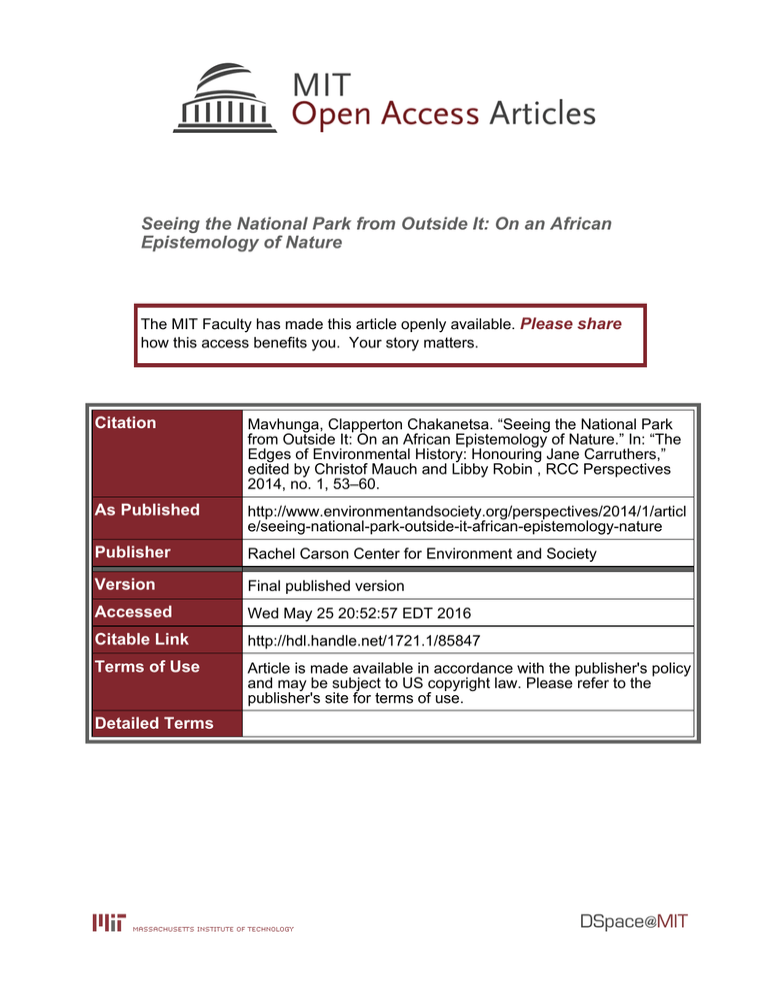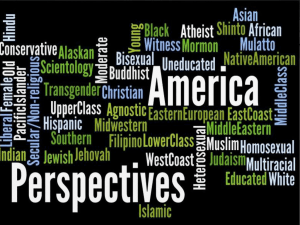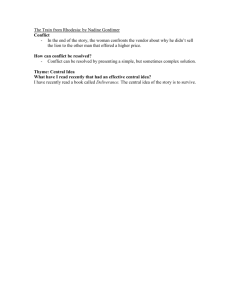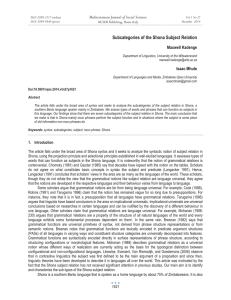Seeing the National Park from Outside It: On an African
advertisement

Seeing the National Park from Outside It: On an African Epistemology of Nature The MIT Faculty has made this article openly available. Please share how this access benefits you. Your story matters. Citation Mavhunga, Clapperton Chakanetsa. “Seeing the National Park from Outside It: On an African Epistemology of Nature.” In: “The Edges of Environmental History: Honouring Jane Carruthers,” edited by Christof Mauch and Libby Robin , RCC Perspectives 2014, no. 1, 53–60. As Published http://www.environmentandsociety.org/perspectives/2014/1/articl e/seeing-national-park-outside-it-african-epistemology-nature Publisher Rachel Carson Center for Environment and Society Version Final published version Accessed Wed May 25 20:52:57 EDT 2016 Citable Link http://hdl.handle.net/1721.1/85847 Terms of Use Article is made available in accordance with the publisher's policy and may be subject to US copyright law. Please refer to the publisher's site for terms of use. Detailed Terms How to cite: Mavhunga, Clapperton Chakanetsa. “Seeing the National Park from Outside It: On an African Epistemology of Nature.” In: “The Edges of Environmental History: Honouring Jane Carruthers,” edited by Christof Mauch and Libby Robin, RCC Perspectives 2014, no. 1, 53–60. All issues of RCC Perspectives are available online. To view past issues, and to learn more about the Rachel Carson Center for Environment and Society, please visit www.rachelcarsoncenter.de. Rachel Carson Center for Environment and Society Leopoldstrasse 11a, 80802 Munich, GERMANY ISSN 2190-8087 © Copyright is held by the contributing authors. The Edges of Environmental History Clapperton Chakanetsa Mavhunga Seeing the National Park from Outside It: On an African Epistemology of Nature This paper explores the concept of “nature” from the perspective of African meanings and practices that national parks or game reserves found in existence, displaced to “the other side of the fence,” and criminalised as poaching during and after the colonial moment.1 They readily manifest themselves in the form of villagers entering the forests now designated national parks in search of firewood, mushrooms, and other wild vegetables, grasses for thatching roofs, fishing, edible mopani worms, and meat. These meanings are deemed poaching and anathema to biodiversity conservation. Part of the problem lies in the interpretation of these activities at face value (poaching), as a legal issue rather than one of environmental knowledge. The aim of this paper is therefore to locate these practices within a broader spiritually grounded relationship between people, animals, forests, mountains, and the natural environment. Through a cross-reading of oral traditions, praise poems, tales, and practices handed down across generations, I propose to see “poaching” as a range of criminalised innovative practices, beliefs, and knowledge handed down and evolving from generation to generation through performance, memory, and oral transmission.2 These practices govern the human-nature relations outside the park, while Western biodiversity thinking is sovereign inside the conservancy. The park and the village became neighbours under circumstances of conflict. The former was created out of the forced removal of the latter from preferred to arbitrary settlements under colonial rule in the late nineteenth and through the twentieth centuries. People might have been physically removed and resettled outside, but their hearts, spiritualities, and material yearnings never left the land that became the national park. They remained inside it, and interpreted its landscapes according to their own meanings and practices. 1 Jane Carruthers, The Kruger National Park: A Social and Political History (Pietermaritzburg: University of Natal Press, 1995), 89. 2 Fikret Berkes, Sacred Ecology: Traditional Ecological Knowledge and Resource Management (Philadelphia: Taylor and Francis, 1999), 8; Chuck Striplen and Sarah DeWeerdt, “Old Science New Science: Incorporating Traditional Knowledge into Contemporary Management,” Conservation in Practice 3, no. 3 (2002): 20; Iain J. Davidson-Hunt and Fikret Berkes, “Changing Resource Management Paradigms, Traditional Ecological Knowledge, and Non-Timber Forest Products,” in Forest Communities in the Third Millennium, ed. I. Davidson-Hunt et al., 78–92 (St. Paul: USDA Forest Service, 2000). 53 54 RCC Perspectives Since colonial times, the problem with biodiversity conservation and game parks has been that it drags neighbouring African communities into the protection of the animals that were the very reason for their forced removals. Token “incentives” or “benefits,” such as a piece of meat for every elephant or buffalo bull killed by rich trophy hunters and gun rights advocates from overseas, and “participation” in conservation projects (seldom at conception, sometimes at implementation), were dangled in front of the villagers. Neither of these wholeheartedly addresses the villagers’ interests but merely extend token “incentives” to them, in order to save the animals and make a profit from those who enjoy killing a whole elephant or buffalo for its horns. There has been much discussion globally about integrating indigenous knowledge into Western scientific methods used in environmental impact assessments, sustainable agriculture, biodiversity conservation, and medical practice.3 However, governments, NGOs, and corporate players often integrate the knowledge itself without real empowerment of its originators, or simply use it to hoodwink them into exploitative relationships. The partnership might end up being one between a rider and a horse.4 That is why, besides exploring the politics and sociology of the park itself from within, as Jane Carruthers, Terence Ranger, and others did, it is equally if not even more important to explore these “forests” from outside, through the lens of a villager, so that we see what these trees, animals, rocks, rivers, and being in them means. The discussion that follows considers the meanings of nature in the traditions and trajectories of thought and practices as imagined from the village. My suggestion is that sometimes it is difficult to locate Africans in environmental history because of a lack of appreciation for the philosophies undergirding their practices. Here, the focus shall therefore be exclusively on connections, philosophy, and practice, taking the example of vaShona, the predominant cultural-linguistic group in Zimbabwe. 3 John Sallenave, “Giving TEK its Rightful Place in Environmental Impact Assessment,” Northern Perspectives 22, http://www.carc.orgipubs/v22no1/know.htm. 4 Clapperton Mavhunga, “Even a Rider and a Horse are a Partnership,” Otyx 41, no. 4 (2007): 441–42; C. Mavhunga and Wolfram Dressler, “On the Local Community: The Language of Disengagement?” Conservation and Society 5, no. 1 (2007): 44–59; Barbara Tapela, Lamson Maluleke, and Clapperton Mavhunga, “New Architecture, Old Agendas: Perspectives on Social Research in Rural Communities Neighbouring the Kruger National Park,” Conservation and Society 5, no. 1 (2007): 60–67. The Edges of Environmental History Until the advent of Christianity in the late-nineteenth century, ancestral spirituality was the sole bedrock of life among vaShona. In their cosmovision, there were moments when the human and animal realms were divisible and rigidly enforced, and others in which humanity and animality were indivisible. The kingdom of humanity and animals had one sovereign, the mhondoro, who was at once a real lion, king of the forest, and the most senior ancestral spirit (mudzimu), a deceased chief or clan founder who after death returned in spirit to look after the living. It was the mhondoro and the mhondoro alone who could intercede between Mwari (god) and the living. This senior spirit manifested itself and spoke to the living via its human medium, the svikiro (port of arrival), growling like a lion before and between words.5 To see a real lion was, therefore, to see the clan spirit. Inevitably, the human domain (the village) and the animal domain (the forest) converged upon the mhondoro. The most revelatory site of this convergence is the burial of a chief, which was no mere disposal of flesh but the first stage in the birth of an ancestral spirit. That process involved the convergence of lion and actual human matter. That is why among the vaUngwe, a Shona people living in the eastern Zimbabwe area of Rusape, the liquid drained from the deceased chief’s mummifying body was collected and buried separately from the corpse. Out of this liquid was believed to rise a lion or mhondoro, hence people were forbidden from killing a lion lest it be the reincarnation of the chief. Another Shona people called the Saunyama, also in the eastern Zimbabwe area of Nyanga, believed that a lion cub “takes up its abode in the grave and there it is fed by guardians of the tomb.”6 When sacrificing a black bull or ox to the mhondoro, some Shona societies left it in the open overnight. If they found the carcass gone, the spirits had accepted the sacrifice; if not even any footprints were found, they had rejected it and were not happy about something.7 VaShona generally believed that mhondoro sent certain animals to communicate with them, especially in times of danger. Chapungu (the bateleur eagle) was the sentinel and messenger-in-chief of the ancestral spirits. The mhondoro sent this bird especially when a relative was walking on the road or camping in the forest, or in wartime, to warn of impending danger or to reassure people that all was well.8 Chapungu communicated through 5 Friedrich Wilhelm Traugott Possett, Fact and Fiction: A Short Account of the Natives of Southern Rhodesia (Bulawayo: Government of Southern Rhodesia, 1935), 82. 6 Ibid., 82. 7 Ibid., 82–83. 8 Martinus Daneel, Guerilla Snuff (Harare: Baobab Books, 1995), 84–120. 55 56 RCC Perspectives its wing flaps, somersaults, a distinct Kovo-o-o shriek, or a silent, peaceful flight. The ancestors might send kamba the tortoise (or turtle) and kovo the squirrel as well. If kamba kept walking across the footpath or the squirrel crossed the traveller’s path tail-down, the way ahead was good; if kamba stopped or kovo crossed with its tail up, danger lurked ahead and the journey was to be terminated forthwith.9 Witches were believed to be particularly adept at “arming mother nature,”10 even more so against enviable or hated social figures like chiefs. Among the Shona, zvimbwanana, or goblins, “with the shape of a human being covered sparsely with tufts of hair,” were believed to imitate the voice of any human being, and whoever it struck would die.11 The nocturnal witching ensemble was composed of the witch herself (for in Shona society the witch was usually a woman) with a hyena, baboon, or otter for a horse, an owl for a crown, and the plover as a sentinel leading the way ahead. There was such a thing as being armed to the teeth with nature after all. The limbs or innards of animals wild and domestic were believed to make very potent weaponry. The bile of a crocodile was the most potent of poisons; it killed instantly. The muShangwe chief Chihunduro’s political powers were owed to “the war medicine and magic tail he possessed.” Chihunduro was known to use “fierce bees in a calabash” to attack his enemies.12 Every time he was embarking on a military expedition, he “consulted the tail, which stood erect if success were in store” and lay prostrate if the campaign might result in defeat. Both powers of the tail and the bees were disarmed when his wife, given to him by his Rozvi rivals, returned to her people and disclosed her husband’s secrets.”13 This weaponization of deadly insects has resonances in African history with respect to mosquitoes and tsetse flies.14 9 Ibid., 15. 10 Jacob Darwin Hamblin, Arming Mother Nature: The Birth of Catastrophic Environmentalism (Oxford: Oxford University Press, 2013); Posselt, Fact and Fiction, 82. 11 C. Togarepi, “Kudeketera Kwomuroyi,” in Nehanda Nyakasikana: Nhorido Dzokunyikadzimu, ed. T. Jongwe (Gweru: Mambo Press, 1983), 246 12Posselt, Fact and Fiction, 141. 13Ibid. 14 John McNeill, Ecology and War in the Greater Caribbean, 1620–1914 (Cambridge: Cambridge University Press, 2010); Timothy Mitchell, Rule of Experts: Egypt, Techno-Politics, Modernity (Berkeley, CA: The University of California Press, 2002); Lansiné Kaba, “Archers, Musketeers, and Mosquitoes: The Moroccan Invasion of the Sudan and the Songhay Resistance (1591–1612),” Journal of African History 22 (1981): 457–75. The Edges of Environmental History VaShona learned their risk management strategy from a number of animals. The skunk defended itself by covering its enemies in scent, producing a gas-dazed flight. If people ever encountered one, they had to keep it to themselves, hence the adage: adenha chidembo ndechake (if one angers the skunk it is his). And another: chidembo hachivhiyirwe pane vanhu (a skunk is not skinned among people). The Shona knew that “what has entered once and never returned cannot be followed.” That is something that everybody who has encountered a mhungu (Egyptian cobra) knows all too well. Upon entering a hole, the extremely venomous snake immediately turns its head outward, ready to cover itself as the rest of its long body slithers down into the hole through sheer muscular contraction and expansion. For snakes, holes in the ground (normally abandoned clay caverns created by termites, openings between rocks, and hollows in thick tree trunks) were fortresses offering cover when fighting an enemy. So too with lizards (matsvinyu, singular dzvinyu), as in the adage “When a lizard basks in the sun [it is because] it sees [that] a hole [is nearby].” It was this tendency of the reptile to always forage within the proximity of its refuge that left it open to interpretation along two gendered lines. First, with regards to married women, the lizard was the source of a powerful charm to pacify philandering or violent husbands. The reptile was appropriately called chipotanemadziro (the one that never strays far from the walls of the house); its tail was cut off while the poor thing was alive, dried, and ground into a potent mupfuhwira (charm) to tame a troublesome husband.15 For men, the custodians of community security against enemy attack, the lizard was a good teacher of defensive strategy; its lesson to them was never to fight the aggressor outside their stockades and pre-prepared defensive positions. Mountains were equally weaponised. Passes, caves, and highest points were known, with ambush positions being carefully prepared in the camouflaged cliff overhangs overlooking the passes below. The caves were turned into bunkers, stashed with provisions to sustain the occupants for days. The high points were turned into sentinel positions to spot the enemy from afar. It was a common Shona practice for chiefs or kings to settle their most trusted vassals—or cowards—on strategic hilltop settlements and likely enemy approach routes to act as sentinels.16 15 Aaron C. Hodza, Denhe Renduri neNhorimbo (Harare: Mercury, 1980), 19. 16Posselt, Fact and Fiction, 36. 57 58 RCC Perspectives The Duma and Manyika people of southeastern Zimbabwe relied not just on intervisible (mutually visible) hills and the use of smoke (by day) and bonfire (by night) but also sound. At the sighting of an enemy the sentinel immediately blew his hwamanda (trumpet made out of kudu horn), alerting the next one who blew his to alert the one beyond until the entire community got the message. Whereupon all men armed themselves and reported at their chief’s court (if time allowed) or went straight into combat if the enemy was already nigh.17 As the able-bodied men jostled into combat positions among the hill stockades, the women, children, and elderly drove the cattle, goats, and other stock into the mountain passes or even caves. These stockades would have been prepared in peacetime with granaries of food and large pots of water in the caves to accommodate people and livestock for considerably long periods of siege. Shona security was collective security, the division of labour paramount. The wood mouse or mbeva (edible in Shona societies, as opposed to the gonzo, the house rat) inspired this defence system. People caught mice by digging up their burrows (mwena), which were very circuitous, in the process educating themselves about a potential defensive system. When digging, they were taken first to the garingiro (sleeping area) or the bedroom of the mice where they saw the mambuze-mbuze (bedding) composed of fir, feathers, and other soft materials, and then the granary (marishe), where mice stash pilferings from the fields and forests above. From this underground store, one or more mbudo (escape routes) lead to the surface, showing that if Plan A (getting out through the main entrance) failed, mice always had Plan B. So the mice proceeded to diziro, another hole more impregnable to diggers that mice dig and close (kutsindira).18 Shona proverbs say that “a mouse does not dig its underground tunnels without an exit [on the other side].”19 It always seemed to have an “exit strategy.” Mice were also known for preparing well in advance of the lean months ahead, hence “a cane rat [muduhwa] rests only after all reeds are cut down.”20 17 Richard Mahambayedwa Gwabuya Mtetwa, “A Political and Economic History of the Duma of South-Eastern Rhodesia from the Early 19th Century to 1945” (PhD thesis: University of Rhodesia, 1976); H. H. K. Bhila, “Firearms as a Factor in Manyika Politics from the Sixteenth to the Twentieth Century,” Rhodesian History ix (1978): 91. 18 Gerald Chikozho Mazarire, “Defence Consciousness as Way of Life: ‘The Refuge Period’ and Karanga Defence Strategies in the 19th Century,” Zimbabwean Prehistory 25 (2005): 10. 19 Mbeva haicheri mwena usine mbudo. 20 Tsenzi inogara yatema/yadziya. The Edges of Environmental History Other animals “trained” vaShona in the art of vigilance. Having watched baboons post a sentinel on the tree-top and hill while the entire troop devoured crops in people’s fields, and having had their careful stalking of game spoiled by a warning bark from such nharirire (sentinel), the Shona coined a proverb: “That which has barked has said something.”21 Animals did not just make noise or sound—they communicated; they spoke a language to each other. They managed risk to themselves through posting sentinels and calling out warnings. The ostrich, for example, used its height to warn unsuspecting springbucks of an approaching hunter, the buck passing on the message to other animals with its snorts and dartings-about.22 Animals also “taught” vaShona to evade their enemies through camouflage. Deception was the essence of the adage: “to laugh with the upper tooth while hiding the lower one.”23 Indeed, “the tooth is a fool; it smiles even at its enemy.”24 This camouflage was one of the chameleon’s two potent weapons, and it was immortalised in the adage: kungwara kwerwavhi kukusandura mavara (the cleverness of chameleon to change colours [and blend in with its environment]). Thus blended in, the chameleon became invisible to its prey, got behind the fly, remained motionless, then slowly advanced, and when within reach, darted out its tongue with astonishing speed. The fly just vanished. There was no other teacher in the execution of speed and surprise in war, except perhaps the python. Conclusions Jane Carruthers pointed out in 1995 that the moral justification for wildlife protection ignores the exclusion of Africans, especially those at whose expense the park exists, from the parks and their uses. There, “on the other side of the fence [away] from the relatively intact protected ecosystem with its lush grassland and abundant wildlife, live impoverished communities, desperate for land and for access to natural resources.”25 The approach I take here is to see innovation and not just misery on the other side of the fence, knowledge that is being criminalised when it could form a highly original and culturally embedded biodiversity. I do not mean that all vaShona philosophies and practices of 21 Chati homu chareva. 22 John Guille Millais, A Breath from the Veldt (London: Henry Sotheran, 1895), 24, 81. 23 Kusekerera nezino repamusoro wakaruma repasi. 24 Zino irema, rinosekerera nemuvengi waro. 25Carruthers, The Kruger National Park, 89. 59 60 RCC Perspectives nature are consistent within the contemporary and future realities, just as I do not mean that biodiversity conservation is completely alien to Africans. On the contrary, the idea of game reserves was in place before European colonization: The chief designated when, where, and how much could be harvested from the forests. There were strict divisions between masango (forests), minda (fields), mapani (pastures), and misha (villages), each for its specific purposes. The risks of breaking such taboos were known; people seldom dared and were severely punished. These codes of conduct were designed to ensure sustainability and to provide security against catastrophe. Nature was not outside culture; as mhondoro shows, in the spiritual scheme of things, the creatures of the forest and the creatures of the village were all Mwari’s zvisikwa (creations). The village did not end on its edges; nor did the forests.






